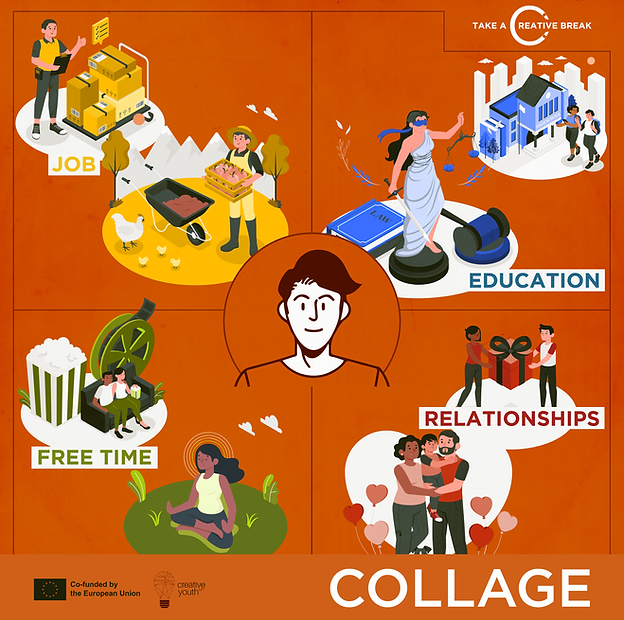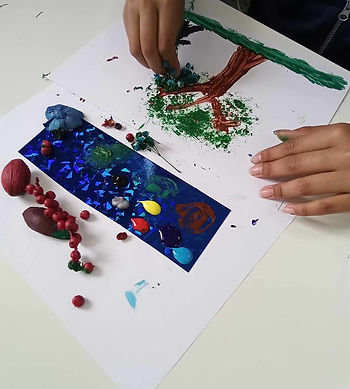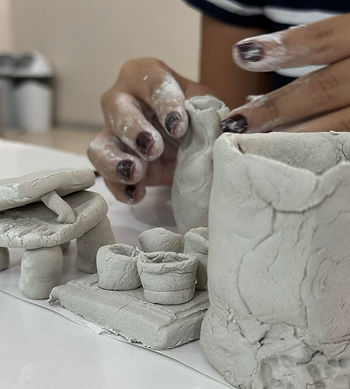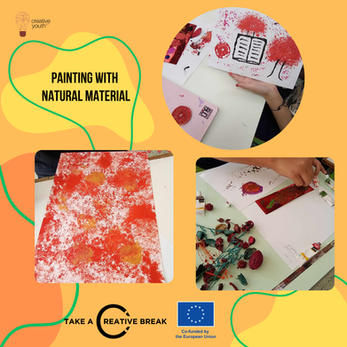

Project's Aim
Use art as a therapeutic tool to encourage self expression and the development of new coping skills.

Project's Objectives
- To provide a safe and non-judgmental environment for individuals to express themselves through art;
- To encourage participants to explore their emotions and thoughts through artistic expression;
- To enhance creativity and promote personal growth through the use of art therapy techniques;
- To facilitate communication and connection among participants through shared creative experiences;
- To provide participants with practical tools and techniques for using art as a means of self-care and stress reduction;
- To increase participants' awareness and understanding of mental health issues and the role that art therapy can play in treatment and recovery.
Idea of the project
Throughout the beginning of time, people have turned to various forms of artistic expression for the purposes of communication, expressing themselves, and finding healing. After seeing that patients suffering from mental illness frequently expressed themselves in the form of drawings and other artworks, many medical professionals began investigating the use of art as a therapeutic method. Since that time, the practice of art therapy has grown to become an integral component of the wider therapeutic community and is included into certain evaluation and treatment strategies. The practice of art, which is essentially pleasurable for the participant, has the potential to be an effective therapeutic tool. It has the potential to provide you with the ability to express your inner ideas while also assisting you in better comprehending and making sense of your feelings and your overall mental health.


Importance of Reflections
Reflections are beneficial for mental health as they encourage self-awareness and emotional understanding. By taking time to thoughtfully consider our thoughts, feelings, and experiences, we gain clarity on challenges and stressors, which can reduce anxiety and overwhelm. Reflecting helps identify patterns in behavior, triggers, and emotional responses, empowering individuals to make healthier decisions. It fosters personal growth, improves emotional regulation, and promotes a sense of calm and balance. Ultimately, reflection offers a powerful way to process emotions and build resilience in the face of life's difficulties.







Activities

Did you know that it is possible to draw mandalas using only paper and a pencil?
Mandalas, which mean "circles" in Sanskrit, are holy symbols utilized for meditation, prayer, healing, and art therapy by adults and children alike.
Clinical research have indicated that mandalas can enhance the immune system, relieve stress and discomfort, lower blood pressure, induce sleep, and alleviate sadness. Furthermore, practicing mandala painting improves attention and boosts self-esteem.


15 easy steps on how to
create your own MANDALA

STEP 1. Prepare paper, pencil, and ruler.

STEP 2. Put a dot in the middle of the paper.

STEP 3. Place dots 2 cm apart from the middle dot, right, left, up, and down.

STEP 4. Place 4 diagonal dots at a distance of 2 cm from the middle dot.

STEP 5. Place a dot 3 cm apart from the last dot on the right.

STEP 6. On all sides, place dots 3 cm apart from the last dots.

STEP 7. Place dots on all sides, 2 cm apart from the last dots.

STEP 8. Connect the dots to make the lines from right to left, up-down, and diagonal.

STEP 9. Connect the dots in a way that creates three circles.

STEP 10. Start making patterns in the first circle. It is important that patterns match in each small triangle.

STEP 11. Move to the second circle and start making patterns there. Make sure that patterns match in each trapezium.

STEP 12. Do the same with the third circle.

STEP 13. Start adding some color to the mandala.

STEP 14. Add more colours to your mandala.

STEP 15. Put the finishing touches on and have your mandala ready!

We invite you to create collages based on four different subjects: job, education, relationships, and free time.
Material needed: old magazines, newspapers, posters, and any other materials to use to create a collage.
The activity's purpose is to engage in active self-reflection and self-discovery while creating visual art from various images.




COLLAGE making

STEP 1. Prepare some old journals and magazines.

STEP 2. Prepare some stickers.

STEP 3. Prepare paper, scissors, glue, and some markers.

STEP 4. Divide the paper into 4 parts and reflect on these 4 questions.

STEP 5. While reflecting start going through journals and stickers to help to find you representations of your ideas.

STEP 6. Cut and put various images and stickers next to each other on the paper. You can also write some words and phrases.




Experimenting painting using various materials.
Painting with your fingers, painting with stencils, painting with flowers, pine cones, and other natural materials will be among them.
Painting allows you to get into your subconscious and express your emotions to yourself and the outer world via the works you produce.
Painting also helps to develop communication skills, emotional intelligence, and self-esteem.




PAINTING with natural material

STEP 1. Prepare a variety of natural materials for painting.

STEP 4. Put the chosen colors on cartoon paper and begin painting with a variety of materials.

STEP 2. Explore how different objects work and what patterns they make.

STEP 5. Allow yourself to relax and unwind while being creative with painting.

STEP 3. Choose the colours and material you will use.

STEP 6. Stay mindful and enjoy the process.



Try to experiment with different forms and shapes of items while working with clay.
Working with clay has a variety of advantages, including increased attention span, imagination, and self-esteem.
Furthermore, the tactile sensation of pottery may be contemplative in nature, eliciting a profound sense of calm and well-being.
When your mind and body get immersed in the realm of creation, your heart rate and blood pressure automatically decrease, your breathing regulates, and your stress level gradually lowers.


CLAY for self-reflections
Working with clay for self-reflection promotes relaxation and stress reduction by engaging the hands in a calming, meditative activity. It also provides a creative outlet for processing emotions, helping to release tension and foster a sense of inner peace.
Take a look at one of the examples below on how to use clay to relax and reflect.

STEP 1. Divide the piece of clay into 3 parts.

STEP 4. Using a second piece of clay, contemplate about your present and craft an object that resonates with it.

STEP 2. Reflect, and with the first piece of
clay, create an object that represents your past.

STEP 5. Once finished with your past and present objects, think about your future and create something that represents it.

STEP 3. Use spatulas and patterns to create your objects.

STEP 6. Now take a piece of paper and write a short story that includes these 3 objects, making sure that at some point in the story there is a dialogue between all of them.

CLAY for self-reflections

Social Media Campaign
Check out art therapy techniques that demonstrate diverse methods of engaging in creative self-reflection, self-discovery, and self-expression, ultimately leading to the discovery of more effective coping strategies when encountering higher levels of stress and anxiety.
















Movies
This material highlights the profound connection between creativity and healing, offering insight into the therapeutic power of art.
Loving Vincent (2017) – This animated film focuses on the life of Vincent van Gogh and how his art became a reflection of his emotional turmoil.
The Diving Bell and the Butterfly (2007) – Based on a true story, it follows a man who, after a stroke, finds solace and expression in writing, despite being almost completely paralyzed.
The Art of Getting By (2011) – This film revolves around a young artist who uses his art to cope with loneliness and existential crises.
My Left Foot (1989) – A true story of Christy Brown, a man born with cerebral palsy, who learns to paint and write using only his left foot, finding a therapeutic outlet in his art.
Frida (2002) – This biopic of Frida Kahlo shows how the artist used painting to express and cope with her physical and emotional pain.
Pollock (2000) – A biographical film about artist Jackson Pollock, highlighting how his artistic process is intertwined with his struggles and emotions.

Documentaries
It reveals the healing potential of artistic creation, offering a deeper look at how individuals use art to navigate emotional, psychological, and physical challenges.
Healing Voices (2016) – This documentary focuses on the role of art and creativity in the recovery of people diagnosed with mental illness, showing how creative expression can be an empowering tool.
Art Therapy: The Movie (2013) – A documentary that takes viewers into the world of art therapy, exploring how creative practices can serve as a path to emotional healing for individuals facing trauma, depression, and other mental health challenges.
The Creative High (2021) – A documentary that follows artists in recovery from addiction, showing how their art is a powerful therapeutic tool in their healing journeys.
Art and Craft (2014) – A documentary about Mark Landis, a mentally ill art forger, that highlights how his relationship with art served as a therapeutic coping mechanism for his psychological issues.
Between the Folds (2008) – This documentary focuses on origami artists and scientists, showing how the meticulous and meditative nature of paper folding can be used to channel emotional energy.
The Creative Brain (2019) – Neuroscientist David Eagleman explores the relationship between creativity and mental health, touching on how engaging in creative activities reduces stress and boosts mental resilience.

Books
These books offer a blend of practical guidance and insights into how art can be used for stress relief, emotional healing, and personal growth.

"The Art Therapy Sourcebook" by Cathy Malchiodi
A comprehensive guide to the practice of art therapy, this book explains how creative expression can serve as a therapeutic tool for healing and stress reduction, offering practical exercises for emotional well-being.
"Art as Therapy" by Alain de Botton and John Armstrong
This book explores how art can be a therapeutic tool for addressing various emotional challenges, including stress, anxiety, and personal struggles, providing insight into how different artworks can guide reflection and healing.
"The Art of Mindfulness: A HarperOne Select" by Thich Nhat Hanh
Combining art and mindfulness, this book emphasizes how creative practices like drawing and painting can be meditative and stress-relieving, leading to inner peace and well-being.
"Art Heals: How Creativity Cures the Soul" by Shaun McNiff
This book offers a deep dive into how engaging in art can promote emotional healing, reduce stress, and foster mental clarity. It includes real-life examples of how creativity has transformed lives through therapeutic practices.
"Mindful Drawing: Bringing Your Mind, Body, and Emotions Back into Balance" by Wendy Ann Greenhalgh
This book introduces mindful drawing as a way to reduce stress, enhance emotional balance, and improve mental health. It combines mindfulness practices with artistic expression, offering step-by-step guides to drawing as a meditative and calming activity.

Articles
These articles explore different aspects of how art can be an effective tool for managing stress, supported by scientific research and practical advice for incorporating creativity into everyday life.

"Assessing Stress Reduction as a Function of Artistic Creation and Cognitive Focus" (Art Therapy: Journal of the American Art Therapy Association) https://www.arttherapy.org/EatingDisorderToolkit/assessingstress.pdf
"Art Activities for Stress Relief" (Verywell Mind) https://www.verywellmind.com/art-activities-for-stress-relief-3144589
"The Art of Destressing: How Creativity Creates Less Stress" (Mental Health Research) https://www.mqmentalhealth.org/the-art-of-destressing-how-creativity-creates-less-stress/
"What is Art Therapy: Understanding Its Benefits and Applications" (Therapy Helpers) https://therapyhelpers.com/therapy-types/what-is-art-therapy/
"Exploring Art Therapy for Coping with Stress" (Healthline) https://www.healthline.com/health/art-therapy-for-coping-with-stress






















